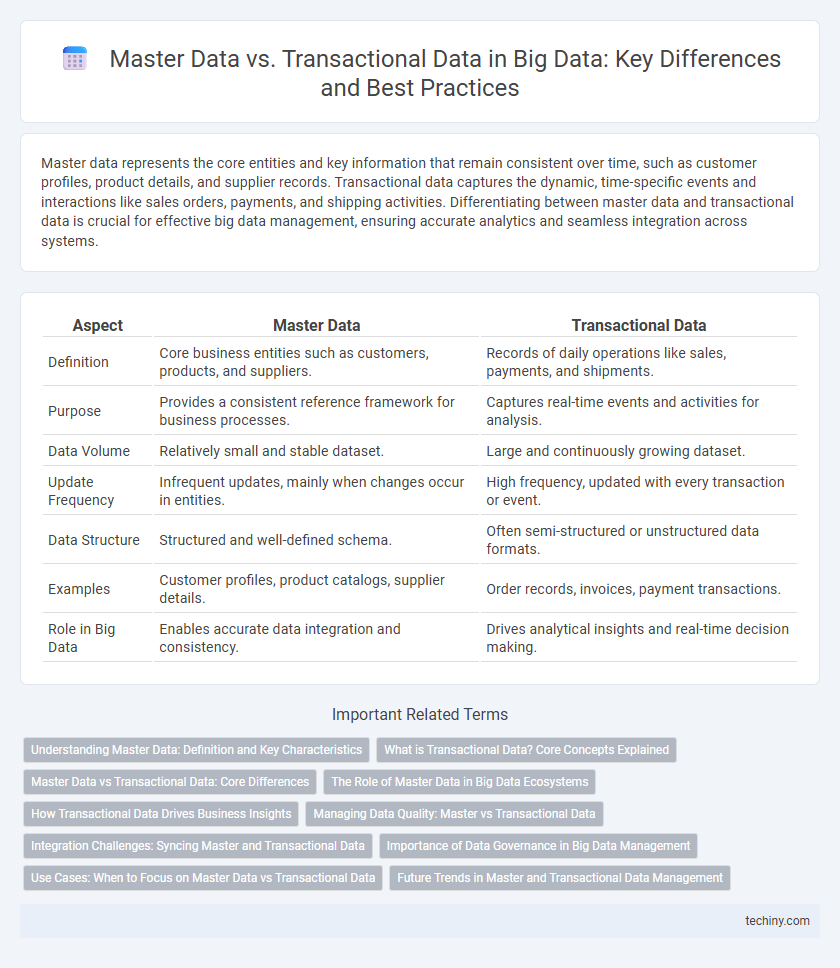Master data represents the core entities and key information that remain consistent over time, such as customer profiles, product details, and supplier records. Transactional data captures the dynamic, time-specific events and interactions like sales orders, payments, and shipping activities. Differentiating between master data and transactional data is crucial for effective big data management, ensuring accurate analytics and seamless integration across systems.
Table of Comparison
| Aspect | Master Data | Transactional Data |
|---|---|---|
| Definition | Core business entities such as customers, products, and suppliers. | Records of daily operations like sales, payments, and shipments. |
| Purpose | Provides a consistent reference framework for business processes. | Captures real-time events and activities for analysis. |
| Data Volume | Relatively small and stable dataset. | Large and continuously growing dataset. |
| Update Frequency | Infrequent updates, mainly when changes occur in entities. | High frequency, updated with every transaction or event. |
| Data Structure | Structured and well-defined schema. | Often semi-structured or unstructured data formats. |
| Examples | Customer profiles, product catalogs, supplier details. | Order records, invoices, payment transactions. |
| Role in Big Data | Enables accurate data integration and consistency. | Drives analytical insights and real-time decision making. |
Understanding Master Data: Definition and Key Characteristics
Master data represents the core entities critical to business operations, such as customers, products, suppliers, and employees, serving as a consistent reference across systems. It remains relatively stable over time, providing a foundation for transactional data that records business events and interactions. Effective management of master data ensures data accuracy, uniformity, and reliability, enabling improved decision-making and operational efficiency in big data environments.
What is Transactional Data? Core Concepts Explained
Transactional data captures specific events, interactions, or transactions occurring in business processes, such as purchases, payments, and reservations. It includes time-stamped records detailing the "what," "when," "where," and "how" of transactions, providing granular insights into operational activities. This data is key for real-time analytics, tracking performance, and supporting decision-making in dynamic business environments.
Master Data vs Transactional Data: Core Differences
Master Data represents the consistent, key business entities such as customers, products, and suppliers, serving as a foundation for organizational data integrity. Transactional Data captures dynamic, time-stamped interactions like sales orders, payments, and shipments, reflecting day-to-day business operations. Understanding the core differences between Master Data and Transactional Data is crucial for effective Big Data management, ensuring accurate reporting and streamlined analytics.
The Role of Master Data in Big Data Ecosystems
Master data serves as the foundational reference data in big data ecosystems, providing consistent definitions and identifiers for entities like customers, products, and suppliers across diverse transactional records. Its role ensures data quality, integrity, and interoperability by linking disparate transactional data sets and enabling accurate analytics and reporting. Effective master data management (MDM) is critical for unlocking actionable insights and driving informed decision-making within large-scale big data environments.
How Transactional Data Drives Business Insights
Transactional data captures individual business activities such as sales, payments, and customer interactions, providing real-time and detailed records essential for analysis. This data enables businesses to identify purchase patterns, monitor operational efficiency, and detect anomalies, driving actionable insights for decision-making. Leveraging transactional data with advanced analytics supports predictive modeling and personalized marketing strategies, enhancing overall business performance.
Managing Data Quality: Master vs Transactional Data
Managing data quality in Big Data environments requires distinct approaches for master data and transactional data due to their differing roles and characteristics. Master data, representing core business entities like customers and products, demands consistency, accuracy, and standardization to ensure reliable analytics and operational efficiency. Transactional data, encompassing individual events and records such as sales or log entries, requires validation, completeness, and timeliness to support real-time decision-making and trend analysis.
Integration Challenges: Syncing Master and Transactional Data
Master data and transactional data integration poses significant challenges due to their differing update frequencies and data structures. Synchronizing master data, which is typically static and authoritative, with high-velocity transactional data requires advanced ETL processes and real-time data pipelines to maintain consistency. Inaccurate syncing leads to data integrity issues, impacting analytics accuracy and operational decision-making in big data environments.
Importance of Data Governance in Big Data Management
Master data provides the foundational, consistent reference information critical for accurate analytics, while transactional data captures ongoing business events reflecting day-to-day operations. Effective data governance ensures the quality, security, and compliance of both master and transactional data within Big Data environments, enabling reliable insights and operational efficiency. Implementing robust data governance frameworks mitigates risks associated with data inconsistency and regulatory violations, ultimately enhancing data-driven decision-making in large-scale data management.
Use Cases: When to Focus on Master Data vs Transactional Data
Master data is critical for maintaining consistent and accurate reference information across enterprise systems, such as customer profiles, product details, and supplier records, making it essential for analytics related to customer segmentation, product lifecycle management, and compliance reporting. Transactional data captures real-time business activities, including sales, payments, and inventory movements, and is vital for operational insights, real-time decision-making, and performance monitoring. Focusing on master data is ideal for strategic initiatives requiring data uniformity, while transactional data is key for dynamic analysis of business processes and immediate response to market changes.
Future Trends in Master and Transactional Data Management
Future trends in master and transactional data management emphasize integrating AI-driven analytics and automated data governance to enhance accuracy and efficiency. Cloud-based platforms and blockchain technology are increasingly adopted to ensure data security, scalability, and real-time synchronization between master and transactional data sets. The convergence of IoT data streams with traditional enterprise data is driving the evolution of unified data ecosystems that support predictive insights and adaptive decision-making.
Master Data vs Transactional Data Infographic

 techiny.com
techiny.com